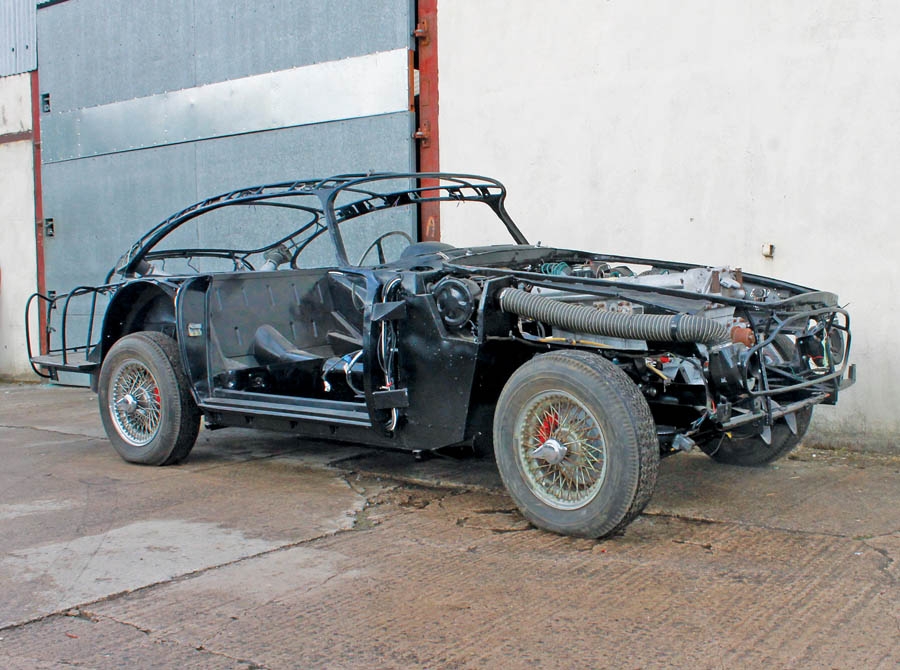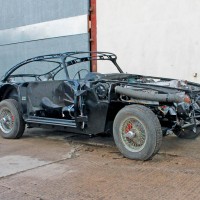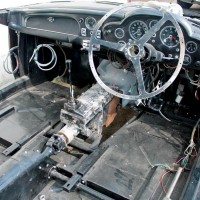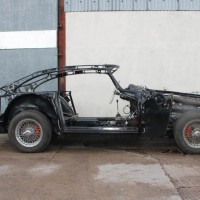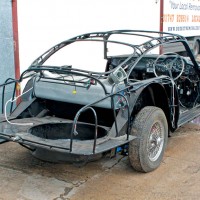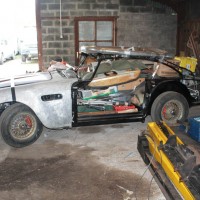SCM Analysis
Detailing
| Vehicle: | 1964 Aston Martin DB5 Sports Saloon Project |
| Number Produced: | 886 |
| Original List Price: | $12,500 |
| Tune Up Cost: | $1,000 |
| Chassis Number Location: | Engine compartment on right side of scuttle |
| Engine Number Location: | Stamped on right side of block |
| Website: | http://www.amoc.org |
| Investment Grade: | B |
This car, Lot 232, sold for $435,422 at Bonhams’ annual sale of Aston Martins at Aston Martin Works, Newport Pagnell, U.K., on May 17, 2014.
This car was very much billed as a “project,” as we can see from the very candid catalog description above with its caveat about “strictly as-viewed.” Nobody was really quite sure exactly what was included and what was missing for DB51497R — and that’s always a problem when someone disassembles a car for restoration, leaving someone else to piece together the jigsaw to put it all back together again.
For anyone who doesn’t know Superleggera Astons intimately, this project is going to be a frustrating nightmare. These cars were hand-built — and subject to constant, ongoing development — so no two are truly exactly alike, which further clouds the issue about what goes where. The chances of messing this car up, and rendering it either worthless or needing another full-cost restoration, are huge, and there are few people in the world who can properly do the job. So offering the car for sale in the place it was built, next door to the people who can still make them like they did in 1964, was a major hint.
Seeing a DB5 unpeeled to skeleton form was a rare and fascinating treat. With the chassis built up and wired and various body sections included, it looked fairly straightforward to complete — if you can weld aluminum and call replicating (or is that wrassling with?) Aston’s Superleggera body construction straightforward.
Although the restoration had been started and the bulk of the heavy lifting looked to have been done, that won’t mean much to the men who’ll have to pick up the pieces. They will have no idea of the integrity of the chassis, or the work done, what’s inside the motor (which was already corroded on the outside), what fits, what belongs to the car and what’s missing.
Why not the prototype DB5 Vantage?
It is going to cost almost as much to restore this DB5 as it would a barn-find basket case. The small posse of Aston Martin Works craftsmen, taking a tour of the auction fare, told me that they’d have to start from scratch if they got the job.
“I’d rather start with this,” one said, indicating Lot 216.
Lot 216? Ah yes, on the other side of the workshop stood the prototype DB5 Vantage — or rather three quarters of it, because a front wing had been cut off to start accident repair to the chassis, and the motor was out. Earlier in the day, it had rather ignominiously made its way into the hall under human power on two back wheels and a trolley under the front, but it had a much more interesting story to tell.
Being a prototype, it bore an Aston Martin experimental DP chassis number, in this case 217, and had been gifted to the Aston Martin Owners’ Club, which had decided that restoration work was beyond it. And although it looked like a scrapper, it was much less messed-about with than Lot 232. I was there when the AM Works boys got quite excited when they discovered 217 stampings on the filler necks, proving it was what it purported to be — the 1963 Works DB5 Vantage prototype — which is why it sold for big money, as much as would get you a nice, finished car, and $226k more than our main subject here.
One giant check
Both cars looked absolutely terrifying, and both will need a full restoration likely to cost about the same. Restoration on a DB Aston has never been cheap, but now it’s big business at Aston Martin Works (the new name for the poshly revamped Works Service: It looks like a modern F1 pit in there now, although they’ve kept the stuffed owl on one of the rafters).
“The cost for a ‘back to bare metal’ restoration on a heritage sports car is in the order of £330,000, plus local taxes where applicable,” said spokesman Scott Fisher. “This is a fixed-price figure and ensures the client has certainty around costs as they embark on the exciting process of Aston Martin restoration.”
So that’s around $650,000 in dollars, taking the tab to complete these cars to $1m–$1.3m. Are they there yet? No. Extrapolating the rise of the last few years, which in the DB5’s case has already had a couple of quiet periods, you might expect them to hit that price reliably around 2016–18, but by then the crash — “realignment” or “slowdown,” call it what you will — in values will surely have come and shaken some of the inflation out of the market.
Time was when a DB5 looked a safe bet, and that’s partly what drove the rise in values. Both these projects were bravely bought at these prices. ♦
(Introductory description courtesy of Bonhams.)
[nggallery id=296]
